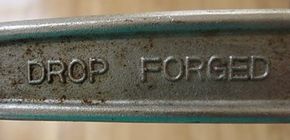Key Takeaways
- "Drop Forged" stamped on tools indicates a manufacturing process where metal is heated and then hammered into a die to form a specific shape. This technique enhances the metal's strength and durability by aligning and stretching its grain structure.
- Drop forging involves using either a powered or falling hammer to shape the hot metal, which is more efficient and produces stronger parts than other manufacturing processes like casting or machining.
- The term reassures consumers about the quality and durability of their tools, as forging tends to produce more robust and reliable products compared to those made by casting or cutting from larger blocks of metal.
You see the words "drop forged" stamped on so many tools -- it makes you wonder what the big deal is! Why do manufacturers want you to know that a tool is drop forged?
If you have ever seen a blacksmith beating on a piece of red hot iron with a hammer, you have seen the simplest type of forging. Striking a piece of hot metal with a hammer is forging, and blacksmiths have been doing this for centuries. As blacksmiths experimented with new techniques, they learned that complex shapes could be created by hammering metal into a die. The die contains the shape of the finished product. Modern manufacturers use either a falling hammer or a powered hammer to do the hammering (rather than doing it by hand), and usually use dies on both sides of the piece. This is drop forging.
Advertisement
Manufacturers now use many different techniques to forge metal. Four of the most common include:
- Drop forging - Hammering hot metal into dies.
- Press forging - instead of forcing hot metal into a die with a hammer blow, it is pressed into the die with hydraulic pressure.
- Roll forging - The hot metal is pressed between two rollers.
- Cold forging - For smaller pieces, the metal can be pressed into the die without heating it significantly ahead of time.
The reason why manufacturers want you to know that a tool is drop forged is because this tells you something about the strength and durability of the tool. The other two ways to make a tool would be casting it from molten metal or machining it (cutting material away) from a larger block of metal. The advantage of forging is that it improves the strength of the metal by aligning and stretching the grain structure. A forged part will normally be stronger than a casting or a machined piece.
Advertisement


